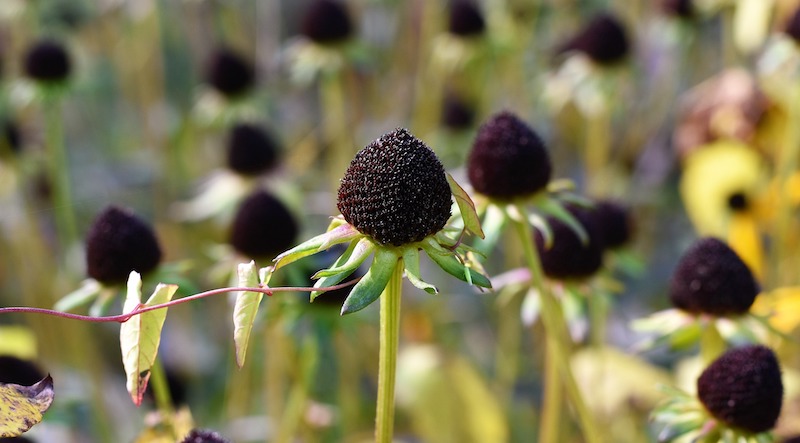Black-Eyed Susans are an herbaceous perennial that fully die back to the ground in the fall. The root system goes dormant during the cold of winter and regrows early in the spring, sending up tender basal leaves first. Overwintering Black-Eyed Susans is easy and involves little extra care.

Protecting Black-Eyed Susans in Winter
The most important thing to monitor during the winter is the drainage in the garden or the container. Root rot is a common problem when plants are left to sit in cold, waterlogged soil for too long. Make sure that gutter downspouts do not drain near or on the planting site. Run-off from driveways, patios, neighboring yards, or streets can also be issues in growing zones that experience heavy winter rains.
Digging up and temporarily potting up a Black-Eyed Susan is one solution that will protect the plant until a new spot can be prepared in the spring. Place newly potted plants in a sheltered location that receives natural rainfall or moisture for the rest of the winter.
Cutting Back Black-Eyed Susans For Winter
Cutting back of dead or dying top growth is the only maintenance that is needed for winter preparation. Cut the stems down to the ground, or to the basal growth if you are gardening in the warmer hardiness zones. Alternatively, the flower stems can be left to cut back in the spring. Birds and other wildlife will feast on the seeds through the winter. The dead plant material will provide extra insulation for the plant crown through the winter.

Black-Eyed Susan Winter Care in Pots
Containers need to have excellent drainage for the plants to overwinter successfully. If the pot is sitting in water at any time, it should be either moved to another location or lifted up on bricks or pot feet. Black-Eyed Susans are hardy perennials that do not need to be brought into an unheated greenhouse or basement to survive the winter. The cold helps them to stay dormant and prepare for new growth in the spring.
Watering Black-Eyed Susans in Winter
Watering during the winter is not usually necessary. The plant roots are not actively growing and can survive on little moisture if needed. In warmer climates, supplemental watering may be needed during long stretches of dry weather. Applying an organic mulch will help conserve soil moisture and insulate the plant crown.
Growing Black-Eyed Susans Indoors
Herbaceous perennials do not make suitable houseplants and do not need to be overwintered in the house. The plants need a period of dormancy to prepare for new growth in the spring.
Steps To Care For Black-Eyed Susans in Winter
Step 1 - Cut back dead and dying top growth in the fall
Step 2 - Mulch with organic compost or shredded leaves around the base of the plant
Step 3 - Leave the seed heads up for birds and other wildlife if you garden in a warmer growing zone
Step 4 - Remove mulch from the crown of the plant as soon as new growth emerges in the spring
Step 5 - Temporarily move any plant or container that is getting too much water to a more sheltered position
 |
Author Robbin Small - Published 7-31-2022 |
